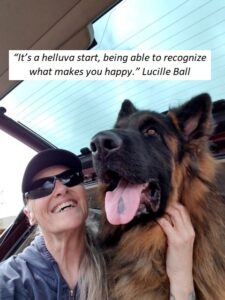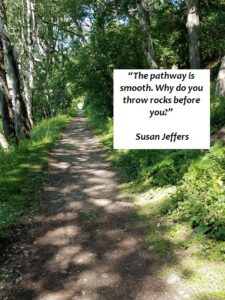Evaluating Your Change Readiness
Charles Swindoll, the founder of Insight for Living, said, “I am convinced that life is 10% what happens to me and 90% how I react to it.”
Whether it’s a change in your job, health, family, relationships, or life in general, change is an inevitable part of life.
Most people don’t like change. For many of us, change can be difficult or uncomfortable. This is true regardless of whether the change is forced upon us, planned, unexpected, or self-created. Why? Because we are giving up familiarity in exchange for the unfamiliar and unknown.
Some people certainly seem to handle change better than others. Most of us know at least one person who has successfully made a major change in their lives such as quitting smoking, losing weight, or walking away from their “Sure Thing” job. Then there are the others—and maybe you count yourself among these people —who give up the minute it gets tough or frightening.
The purpose of this article is to help you evaluate your “change readiness.” Because the secret to success lies in taking an honest look at your attitude towards change and how ready you really are to make those changes.
First Things First
The fact that I try new things in itself is a victory. Lynn Collins
If I’m being honest, I’m not a big fan of Firsts – unless I have some level of confidence before I even begin that I’ll succeed. I’m sure there’s a multi-syllabic word for that syndrome, but I call it, “not wanting to look stupid.”
Many people lead a routine life for all kinds of reasons. We take the same road to work each day, read the same newspapers or types of books, eat at the same restaurants, follow the same schedule on weekends, watch the same channels on TV. And along the way, our “Firsts” begin to slowly evaporate.
Yes, I know firsts can be inspiring, invigorating, and instructive. But sometimes they’re also disheartening, unnerving, and unsettling – and all about change!
Of course, at the heart of this, for most of us, there’s fear – real or imagined – of doing something for the first time. And, sure, someone can ask us, “What’s the worst thing that could happen if you try this?” You might think the answer is obvious; in most cases, trying something new is probably not life-threatening.
But I don’t think it’s that simple. Because each of us has our own understanding of “worst things.”
Sometimes the best FIRST step is to examine how you feel about trying new things, what you define as “worst things,” and how ready you are when unexpected firsts happen in your life.
Ask yourself this:
- When was the last time you did something for the first time?
- When doing something for the first time, how do you feel?
Many people can’t think of anything. Their lives are so routine they haven’t done anything new – unnerving and unsettling new – for years. Because of this, they’ve become fearful of trying new things.
But if we can overcome this fear, we can learn to enjoy doing new things. It can even be stimulating, satisfying, and fun.
At least, that’s what I’ve been telling myself for the last few weeks!
Identifying Your Feelings and Perceptions About Change
“The first step toward change is awareness.” Nathaniel Branden
What if you’ve just been presented with a change and you’re feeling negative or anxious about it? It’s going to happen to every one of us at some point.
Some people have a perception that says, “Change is good, even if (or especially if) it means leaving my comfort zone.” Research shows that 38% of people like to leave their comfort zone.
By contrast, there’s the other 62% of people who either don’t like to leave their comfort zone or do so only occasionally – and only under duress.
However, the overwhelming majority of the time, it’s not the change itself, but rather our perception of it, that makes the situation appear negative. So how can we change the perception?
You begin by looking at how you currently feel about change in general. And asking yourself four simple questions can help you get started:
- How does the thought of change make me feel?
- How do I feel, act, or respond when something changes in my life?
- How would my friends and family describe my ability to handle change?
- How do I feel, act, or respond when faced with the possibility of change or even thinking about initiating a change?
Identifying Your Resistance to Change
“A bend in the road is not the end of the road…unless you fail to make the turn.” Helen Keller
If the pandemic showed us anything, it’s that change, whether on a personal level or on a global scale, is definitely achievable.
Resistance to change is the unwillingness to adapt to new circumstances or ways of doing things. It can happen with individuals, relationships, or within organizations. There are many reasons for resistance, but at its heart, resistance is rooted in fear – fear of the unknown, of failing, of not doing something “perfectly.” People are biologically wired to look for patterns and predictability, and any uncertainty — even if it’s anticipated or positive — can trigger anxiety.
Our minds are amazingly adaptive, but an individual’s brain can have a hard time focusing if fear is a concern. This is because while some parts of the brain are actively engaging with new information, other parts of the mind are shutting down.
To begin to remove any self-imposed barriers, we need to identify the causes of our resistance.
So to get started, think about a change you haven’t done yet even though it’s really important to you.
Then, ask yourself the following questions about that change:
- What’s getting in the way or slowing me down?
- How much do I really want it?
- How can I make it feel more achievable?
Let’s take a close look at each of these questions.
- What’s getting in the way or slowing me down?
With any change there will be barriers, things that will either slow us down, distract us, or knock us off course. Even when we’re feeling highly motivated to change, too many barriers, if not addressed, will cause us to run out of steam, lose focus, or become exhausted.
These barriers may be lifestyle. For example, if giving up alcohol, our resolve will be tested when meeting friends in a bar. If adopting a strict vegan diet, then restaurant food choices may be more limited. Other barriers may be our fear of the uncertainty of the change or the consequences if it doesn’t go as expected. Or, we may have to give up something that turns out to be harder than thought it would be.
These obstacles will frustrate the change process and make it harder. They will use up valuable motivational energy, like leaving the parking brake on while trying to drive.
Imagine a new exercise routine where three times a week you’re going to get up early and exercise before work. However, once you’re out of bed at 5:30 AM but you can’t find your sweats in the dark, the dog has hidden your shoes, and the bike has a flat tire, there’s a real chance that you’ll abandon the whole thing and go back to bed.
The point is that there will always be barriers and we won’t necessarily be able to remove all of them. But taking time to at least mitigate the effect will help the change move forward with greater ease. Think of it as clearing the path in order to make it a little easier for yourself.
- How much do I really want it?
If you’ve ever tried making changes, whether big or small, you may have noticed that some go well, and others are more challenging. In some cases, they may end up being nothing more than a good intention that never happened.
You may also have noticed that sometimes you are full of energy and resolve to make the thing happen, and at other times, what may seem like a great idea on paper just doesn’t get going at all. Of course, we make lots of excuses about too much to do, not feeling in the right place, other people making it too difficult for us – and the list goes on. We may say we believe in the change and yet it’s hard to engage or do anything meaningful to make the change happen.
This typically points towards insufficient motivation. Put simply we’re not emotionally invested in the change. We may think it looks like a good idea, like losing a few pounds for the summer, but when it really comes to the sacrifices we might have to make, it’s just not important enough to us. Most of us are constantly juggling many priorities and making decisions every moment of every day about what we’ll put our attention to. If we’re not emotionally invested, believing completely in the purpose, we’ll consciously or unconsciously let something else get the way. The result is of course that we don’t move forward.
The answer to addressing this essentially comes down to a simple choice: a) dig a little deeper on why we want this change in the first place and why it’s so important to us; or b) pull the plug on the whole idea, focus on something else, and stop wasting time worrying about it. That may sound harsh, but you’d be amazed how much time is wasted by not really understanding that the choice is being made whether we’re aware of it or not.
Following the exercise analogy, when the alarm goes off at 5:30 A.M. it’s dark outside and everyone else is asleep. It’s at that point you’ll find out just how motivated you are, especially a few weeks in.
- How can I make it feel more achievable?
If a change doesn’t actually feel achievable or it’s not clear what we need to do next, there’s a good chance we’ll get caught up in our life or work activities and nothing will actually happen. We’re all busy, and most of us are constantly using our mental energy to deal with what life throws at us. When making changes, it’s important to think ahead about specifically how we’re going to achieve it and make it easier on ourselves to juggle the different things that draw on our time and attention.
Improving Your Change Readiness
“Life is about not knowing, having to change, taking the moment and making the best of it, without knowing what’s going to happen next.” Gilda Radner
Thinking about the question, “How can I make it feel more achievable,” now let’s look at how we can make it more achievable.
Regardless of the nature and scale of the change you’re trying to make, there are five simple strategies you can use to better understand how ready you are to change and, more importantly, what you could do to increase your chance of achieving the outcomes that matter to you.
- Break the change into manageable parts.
Find things that can be done relatively. This gives you a real sense of progress and achievement as you tick things off your list and move towards your goal. - Plan ahead and decide when you are actually going to do the things you’ve decided to do. If you took my Fix It or Forget About It webinar, you’ll remember that we talked about this. By planning ahead, I mean actually scheduling time for it in your calendar. If you don’t actively make time for the tasks you need to do, they will very likely end up as one of those things you didn’t get around to today. Most of us are all too familiar with that one! As Robin Sharma is often quoted as saying: “What get’s scheduled gets done.”
Thinking about that exercise analogy again, planning to do it on specific days of the week and preparing everything you need ahead of time can help greatly reduce the chance that it won’t happen.
It’s critical that you make time for it and stick to it. When asking how something you wanted to change became six months late, the answer is always one day at a time. In other words, each day matters.
So, if you’re not achieving your goals or not getting there quickly enough, then you need to really examine the reasons why and be honest about what’s stopping you doing what you have decided is important.
- Make the change a habit in order to sustain it long term.
If you are a regular gym member, then you’ll have noticed how the parking lot is pretty full during the first few weeks of January. By the end of February, things tend to revert back to normal. We come out of the holidays full of resolve and enthusiasm to become fitter and healthier, and then we all too often fall back into our old habits and struggle to sustain them. Making the change in the first place is one thing. Sustaining it over the long term is something else.
Behavioral specialists point out that around 85% of what we do each day is habit driven. Habits are things we do without really thinking. They are an energy-saving device for the brain, allowing it to focus on novel and complex tasks. Driving a car or brushing our teeth are obvious habitual examples: often we find ourselves doing them without being consciously aware of it. Habits can either be good for us or not, and either way we’re likely to continue them unless we consciously form a different habit. That takes time and consistency; according to experts, a new habit takes somewhere between 50 and 130 days to fully embed, depending upon the nature of it.
To change our behavior, we need to be clear on what a good habit looks like, find ways to discourage the bad habits or behaviors, and encourage or reward the desired new ones, so it becomes easier and more desirable to do the right thing. Consistency is really important here too in order to ensure that we don’t slip back into our old ways.
One last thing on making changes stick – it takes time to adjust. With any substantial change, it can feel uncomfortable for a while and things may take a little longer or slow down for a while until we get used to them so it’s important to allow time for that to happen.
- Identify what you’re learning and how you can use that to adapt your approach.
As the saying goes, it’s very easy to keep doing the same thing over and over and expecting a different result. It’s important to regularly reflect honestly about how the change is going, what’s working, and what could be improved.
It’s easy to fall into the trap of assuming that things will stay as they are. If the pandemic showed us anything, it’s that things can change very quickly, and so we need to ensure that the change we’re making is still as relevant as it was when we started. Has anything changed that means we should change our approach to the change we’re making? Should we abandon it altogether?
Since habits can take a long time to learn or break, you need to be willing to assess as you go. This is called “learn and adapt.” Adaptability is a core human quality and has served us well for many thousands of years but only if we allow ourselves the time to assess and reflect honestly and without undue bias, and then act decisively on what we’ve learned.
Back to the exercise analogy: If we are to hit our fitness goals that we’ve set ourselves then we need to periodically step back and reflect honestly about what’s working and what’s not going so well and where we could improve.
- Don’t let the “What Ifs” deter you.
What Ifs usually focus on the uncertainty of the outcome of something we want to do, be, or have.
You come to a fork in the road. One way is something you’re familiar with. The other way is a road you’ve never taken. What might happen if you do take that unknown route? What are the odds that something bad might happen if you go that way? Is it worth the risk?
This is all about the devil we know – and most of us fear that something bad might happen and so we take the known road.
Remember how I said that I’m not a big fan of Firsts – unless I have some level of confidence before I even begin that I’ll succeed? Fear of thinking “What if I look stupid” can easily derail me.
But what if the “What Ifs” never happen?
Thinking back to a time when you took a risk despite the What Ifs, how many of those What Ifs actually came to pass?
Ask yourself this: What if everything does work out exactly how you imagined it?
Go Forth and Change!
“The most important step of all is the first step. Start something! Not only is taking that first step less difficult than you may imagine, but it may change your life in wonderful ways.” Blake Mycoskie
I hope you’ve found some insights about your change readiness – and maybe even a little courage to take that first step!
Evaluating Your Change Readiness Read More »



